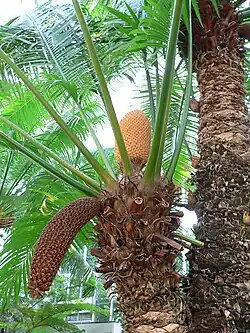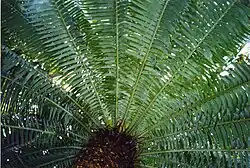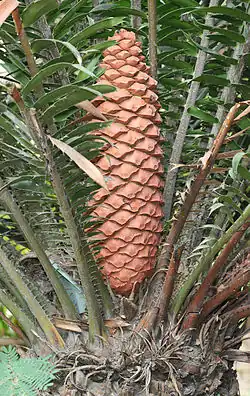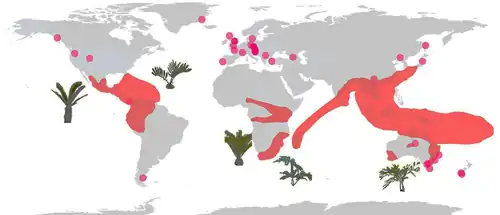Cycad
| Cycadales Temporal range:
| |
|---|---|

| |
| Cycas rumphii with old and new male strobili. | |
| Scientific classification | |
| Kingdom: | Plantae |
| Clade: | Tracheophytes |
| Clade: | Spermatophytes |
| Clade: | Gymnospermae |
| Division: | Bessey 1907: 321.[2] |
| Class: | Brongn.[1] |
| Order: | Pers. ex Bercht. & J. Presl |
| Extant groupings | |
| Synonyms | |
| |
Cycads /ˈsaɪkædz/ are seed plants with a stout, woody cylindrical trunk with a crown of large, hard, stiff, evergreen and usually pinnate leaves. The species are dioecious, that is, individual plants of a species are either male or female. Cycads vary in size from having trunks only a few centimeters to several meters tall. They typically grow slowly and have long lifespans. They superficially resemble palms or ferns, but are not closely related to either group. Cycads are gymnosperms. Cycads have specialized pollinators, usually a specific beetle, and more rarely a thrips or a moth.
Both male and female cycads bear cones (strobili), somewhat resembling conifer cones. Cycads fix nitrogen in association with cyanobacteria living in the plants' roots. Some species are used as narcotics, while in Vanuatu the plant symbolizes peace and appears on the national flag. Cycads all over the world are in decline, with four species on the brink of extinction and seven species having fewer than 100 plants left in the wild.
Description
Cycads are seed plants with a stout, woody, and usually unbranched cylindrical trunk, and a crown of large, hard, stiff, evergreen and (usually) pinnate leaves. The species are dioecious, that is, individual plants of a species are either male or female. Cycads vary in size from having trunks only a few centimeters to several meters tall. They typically grow slowly[3] and have long lifespans. Because of their superficial resemblance to palms or ferns, they are sometimes mistaken for them, but they are not closely related to either group. Cycads are gymnosperms (naked-seeded), meaning their unfertilized seeds are open to the air to be directly fertilized by pollination, as contrasted with angiosperms, which have enclosed seeds with more complex fertilization arrangements. Cycads have very specialized pollinators, usually a specific beetle, and more rarely a thrips or a moth.[4]
The leaves are pinnate (shaped like feathers), with a central leaf stalk from which parallel ribs emerge from each side of the stalk, perpendicular to it. The leaves are typically either compound, or have margins so deeply cut as to appear compound. The Australian genus Bowenia and some Asian species like Cycas multipinnata, C. micholitzii and C. debaoensis, have bipinnate leaves, the leaflets each having subleaflets.[5] The apex of the stem is protected by modified leaves called cataphylls.[6]
Cycads superficially resemble palms in foliage and plant structure, occur in similar climates, and are often mistaken for them. However, they are so distantly related that they are classified in different phyla. Their similarities are caused by convergent evolution. Differences between cycads and palms include the cones (strobili) of cycads: they are gymnosperms, whereas palms are flowering plants and bear fruit. Both groups' mature foliage look similar, but young emerging cycad leaves – before they unfold and shift into place in the rosette crown – resemble a fiddlehead fern; in contrast, new leaves of palms are just miniature versions of a mature frond. Another difference is in the stem: Both phyla show scarring on their stems – below the rosette, where leaves used to attach – but the scars on a cycad's trunks are helically arranged and small; the scars on palm trunks are a circle, that wraps around the whole stem. The stems of cycads are generally rougher and shorter than those of palms.[7]
-
.jpg)
-
 Rosette of pinnate leaves around a cylindrical trunk
Rosette of pinnate leaves around a cylindrical trunk -
 Leaves and strobilus of Encephalartos sclavoi
Leaves and strobilus of Encephalartos sclavoi -
Bowenia spectabilis: plant with single leaf
Evolution
Fossil record

The oldest probable cycad foliage is known from the latest Carboniferous / early Permian of South Korea and China, such as Crossozamia. Unambiguous fossils are known from the early / middle Permian onwards.[8] Cycads were uncommon during the Permian.[9] The two living cycad families diverged from each other at some time between the Jurassic[10] and Carboniferous.[11] Cycads are thought to have reached their apex of diversity during the Mesozoic.[12] Although the Mesozoic is sometimes called "The Age of Cycads", some other groups of distantly related extinct seed plants with similar foliage, such as Bennettitales and Nilssoniales, were considerably more abundant than cycads during the Mesozoic: the "true" cycads were only minor components of Mesozoic vegetation.[13] The oldest records of the modern genus Cycas are from the Paleogene of east Asia.[14] Fossils assignable to Zamiaceae are known from the Cretaceous,[13] with fossils assignable to living genera of the family from the Cenozoic.[15]
Phylogeny
The two extant families of cycads both belong to the order Cycadales, and are the Cycadaceae and Zamiaceae (including Stangeriaceae). These cycads have changed little since the Jurassic in comparison to some other plant divisions.[10] Based on genetic studies, cycads are thought to be more closely related to Ginkgo than to other living gymnosperms. They diverged from each other during the early Carboniferous.[16][17]
| External phylogeny[16][17] | ||||||||||||||||||||||||||||||||||||||||
|---|---|---|---|---|---|---|---|---|---|---|---|---|---|---|---|---|---|---|---|---|---|---|---|---|---|---|---|---|---|---|---|---|---|---|---|---|---|---|---|---|
|
| Internal phylogeny[10][15] | |||||||||||||||||||||||||
|---|---|---|---|---|---|---|---|---|---|---|---|---|---|---|---|---|---|---|---|---|---|---|---|---|---|
|
Taxonomy
Classification of the Cycadophyta to the rank of family.[18]
- Class Cycadopsida Brongniart 1843
- Order Cycadales Persoon ex von Berchtold & Presl 1820
- Suborder Cycadineae Stevenson 1992
- Family Cycadaceae Persoon 1807
- Genus Cycas
- Family Cycadaceae Persoon 1807
- Suborder Zamiineae Stevenson 1992
- Family Zamiaceae Horaninow 1834
- subfamily Diooideae Pilg. 1926
- Tribe Diooeae Schuster
- Genus Dioon
- Tribe Diooeae Schuster
- subfamily Zamioideae Stevenson 1992
- Tribe Encephalarteae Miquel 1861
- Genus Macrozamia
- Genus Lepidozamia
- Genus Encephalartos
- Tribe Zamieae Miquel 1861
- Genus Bowenia
- Genus Ceratozamia
- Genus Stangeria
- Genus Zamia
- Genus Microcycas
- Tribe Encephalarteae Miquel 1861
- subfamily Diooideae Pilg. 1926
- Family Zamiaceae Horaninow 1834
- Suborder Cycadineae Stevenson 1992
- Order Cycadales Persoon ex von Berchtold & Presl 1820
Fossil genera
The following extinct cycad genera are known:[19]
- Amuriella Late Jurassic, Russian Far East (leaf fragments)
- Androstrobus Triassic to Cretaceous, worldwide (leaf form genus)
- Antarcticycas Middle Triassic, Antarctica (known from the whole plant)[20]
- ?Anthrophyopsis Late Triassic, worldwide (leaf form genus, possibly a pteridospermatophyte)[21]
- Apoldia Triassic-Jurassic, Europe
- Archaeocycas Early Permian, Texas (leaf with sporophylls)
- Aricycas Late Triassic, Arizona (leaf form genus)
- Beania (=Sphaereda), Triassic to Jurassic, Europe & Central Asia (leaf form genus)
- Behuninia Late Jurassic, Colorado & Utah (fruiting structures)
- Bucklandia Middle Jurassic to Early Cretaceous, Europe and India (leaf form genus)
- Bureja Late Jurassic, Russia
- Cavamonocolpites Early Cretaceous, Brazil (pollen)
- Crossozamia Early to Late Permian, China (leaf form genus)
- Ctenis Mesozoic-Paleogene, Worldwide (leaf form genus)
- Ctenozamites Triassic-Cretaceous, worldwide (leaf form genus)
- Cycadenia Triassic, Pennsylvania (trunks)
- Cycadinorachis Late Jurassic, India (rachis)
- Fascisvarioxylon Late Jurassic, India (petrified wood)
- Gymnovulites, Latest Cretaceous/earliest Paleocene, India (seed)
- Heilungia, Late Jurassic to early Cretaceous, Russia & Alaska (leaf form genus)
- Leptocycas Late Triassic, North Carolina & China (known from the whole plant)[22]
- Mesosingeria, Jurassic to Early Cretaceous, Antarctica & Argentina (leaf form genus)
- Michelilloa, Late Triassic, Argentina (stem)
- ?Nikania, Early Cretaceous, Russia (leaf fragments)
- ?Nilssonia, Middle Permian to Late Cretaceous, worldwide (leaf form genus) (possibly not a cycad)[23]
- ?Nilssoniocladus, Early to Late Cretaceous, United States & Russia (stems, likely associated with Nilssonia, possibly deciduous)[24]
- Palaeozamia, Middle Jurassic, England
- Paracycas, Middle Jurassic to Late Jurassic, Europe and Central Asia
- ?Phasmatocycas, Late Carboniferous to Early Permian, Kansas, Texas & New Mexico (leaf with sporophylls)[25]
- Pleiotrichium, Late Cretaceous, Germany (leaf)
- Pseudoctenis, Late Permian to Late Cretaceous, worldwide (leaf form genus)
- Sarmatiella, Late Triassic, Ukraine
- Stangerites, Late Triassic to Early Jurassic, Virginia and Mexico (leaf form genus)
- Sueria, Early Cretaceous, Argentina (leaf)
- Taeniopteris, Carboniferous to Cretaceous, worldwide (polyphyletic leaf form genus, also includes bennettitales and marattialean ferns)
Distribution and ecology

The living cycads are found across much of the subtropical and tropical parts of the world, with a few in temperate regions such as in Australia.[27] The greatest diversity is in the Americas, but they also grow in China, South and Southeast Asia, Pacific islands, and southern and tropical Africa.[28][26] Some are xerophytes that can survive in desert or semi-desert climates,[29] others in wet rain forest conditions,[30] and some in both.[31]
Cycads accomodate nitrogen-fixing cyanobacteria in their coralloid roots.[32] The cyanobacteria produce a neurotoxin, BMAA, that accumulates in the plant's seeds.[33][34] Another defence against herbivores is the accumulation of toxins in seeds and vegetative tissues; through horizontal gene transfer, cycads have acquired a family of genes (fitD) from a microbe, most likely a fungus, which gives them the ability to produce an insecticidal toxin.[35]
Interaction with humans
Nuts of Cycas orientis (nyathu) are eaten by the Yolngu in Australia's Arnhem Land. They are harvested on their dry season to leach its poison under water overnight before ground into a paste, wrapped under bark and cooked on open fire until done.[36] A pair of namele cycad leaves, representing peace, appears on the Flag of Vanuatu.[37][38] Cycads are used as narcotics in Mexico, where they are among the substances called "peyote", while in South Africa, Encephalartos is used for the same purpose. In both regions, collecting for the drugs market is harming wild cycad populations.[39] Cycads all over the world are in decline, with four species on the brink of extinction and seven species having fewer than 100 plants left in the wild.[40][41][42]
See also
- Fossil Cycad National Monument, now withdrawn, in the U.S. state of South Dakota
References
- ^ Brongniart, A. (1843). Énumération des genres de plantes cultivées au Muséum d'histoire naturelle de Paris.
- ^ Bessey, C.E. (1907). "A synopsis of plant phyla". Nebraska University Studies. 7: 275–373.
- ^ Dehgan, Bijan (1983). "Propagation and Growth of Cycads—A Conservation Strategy". Proceedings of the Florida State Horticultural Society. 96: 137–139 – via Florida Online Journals.
- ^ Cai, Chenyang; Escalona, Hermes E.; Li, Liqin; Yin, Ziwei; Huang, Diying; Engel, Michael S. (10 September 2018). "Beetle Pollination of Cycads in the Mesozoic". Current Biology. 28 (17): 2806–2812.e1. Bibcode:2018CBio...28E2806C. doi:10.1016/j.cub.2018.06.036. PMID 30122529.
- ^ Rutherford, Catherine; et al. (eds.). CITES and Cycads: A user's guide (PDF). London, England: Royal Botanic Gardens, Kew.
- ^ Marler, T.E.; Krishnapillai, M.V. (2018). "Does plant size influence leaf elements in an arborescent cycad?". Biology. 7 (4): 51. doi:10.3390/biology7040051. PMC 6315973. PMID 30551676.
- ^ Tudge, Colin (2006). The Tree. New York: Crown Publishers. pp. 70–72, 139–148. ISBN 978-1-4000-5036-9 – via Internet Archive (archive.org).
- ^ Spiekermann, Rafael; Jasper, André; Siegloch, Anelise Marta; Guerra-Sommer, Margot; Uhl, Dieter (June 2021). "Not a lycopsid, but a cycad-like plant: Iratinia australis gen. nov. et sp. nov. from the Irati formation, Kungurian of the Paraná basin, Brazil". Review of Palaeobotany and Palynology. 289: 104415. Bibcode:2021RPaPa.28904415S. doi:10.1016/j.revpalbo.2021.104415. S2CID 233860955.
- ^ Gomankov, A.V. (June 2022). "Cycads in the Permian of thе Subangara region". Paleontological Journal. 56 (3): 317–326. Bibcode:2022PalJ...56..317G. doi:10.1134/S0031030122030066. S2CID 249627815.
- ^ a b c Nagalingum, N. S.; Marshall, C. R.; Quental, T. B.; Rai, H. S.; Little, D. P.; Mathews, S. (2011). "Recent synchronous radiation of a living fossil". Science. 334 (6057): 796–799. Bibcode:2011Sci...334..796N. doi:10.1126/science.1209926. PMID 22021670. S2CID 206535984.
- ^ Coiro, Mario; Allio, Rémi; Mazet, Nathan; Seyfullah, Leyla J.; Condamine, Fabien L. (11 June 2023). "Reconciling fossils with phylogenies reveals the origin and macroevolutionary processes explaining the global cycad biodiversity". New Phytologist. 240 (4): 1616–1635. Bibcode:2023NewPh.240.1616C. doi:10.1111/nph.19010. PMC 10953041. PMID 37302411.
- ^ Coiro, Mario; Seyfullah, Leyla Jean (14 March 2024). "Disparity of cycad leaves dispels the living fossil metaphor". Communications Biology. 7 (1): 328. doi:10.1038/s42003-024-06024-9. PMC 10940627. PMID 38485767.
- ^ a b Coiro, Mario; Pott, Christian (December 2017). "Eobowenia gen. nov. from the Early Cretaceous of Patagonia: indication for an early divergence of Bowenia?". BMC Evolutionary Biology. 17 (1): 97. Bibcode:2017BMCEE..17...97C. doi:10.1186/s12862-017-0943-x. PMC 5383990. PMID 28388891.
- ^ Liu, Jian; Lindstrom, Anders J.; Marler, Thomas E.; Gong, Xun (28 January 2022). "Not that young: Combining plastid phylogenomic, plate tectonic and fossil evidence indicates a Palaeogene Diversification of Cycadaceae". Annals of Botany. 129 (2): 217–230. doi:10.1093/aob/mcab118. PMC 8796677. PMID 34520529.
- ^ a b Condamine, Fabien L.; Nagalingum, Nathalie S.; Marshall, Charles R.; Morlon, Hélène (17 April 2015). "Origin and diversification of living cycads: a cautionary tale on the impact of the branching process prior in Bayesian molecular dating". BMC Evolutionary Biology. 15 (1). 65. Bibcode:2015BMCEE..15...65C. doi:10.1186/s12862-015-0347-8. PMC 4449600. PMID 25884423. S2CID 14815027.
- ^ a b Wu, Chung-Shien; Chaw, Shu-Miaw; Huang, Ya-Yi (January 2013). "Chloroplast phylogenomics indicates that Ginkgo biloba is sister to cycads". Genome Biology and Evolution. 5 (1): 243–254. doi:10.1093/gbe/evt001. PMC 3595029. PMID 23315384.
- ^ a b Stull, Gregory W.; Qu, Xiao-Jian; Parins-Fukuchi, Caroline; Yang, Ying-Ying; Yang, Jun-Bo; et al. (19 July 2021). "Gene duplications and phylogenomic conflict underlie major pulses of phenotypic evolution in gymnosperms". Nature Plants. 7 (8): 1015–1025. Bibcode:2021NatPl...7.1015S. doi:10.1038/s41477-021-00964-4. PMID 34282286. S2CID 236141481.
- ^ "Cycadophyta Bessey". World Flora Online. wfo-4100003333. Retrieved 20 August 2025.
- ^ "PBDB". paleobiodb.org. Retrieved 16 March 2024.
- ^ Hermsen, Elizabeth J.; Taylor, Edith L.; Taylor, Thomas N. (January 2009). "Morphology and ecology of the Antarcticycas plant". Review of Palaeobotany and Palynology. 153 (1–2): 108–123. Bibcode:2009RPaPa.153..108H. doi:10.1016/j.revpalbo.2008.07.005.
- ^ Xu, Yuanyuan; Popa, Mihai Emilian; Zhang, Tingshan; Lu, Ning; Zeng, Jianli; Zhang, Xiaoqing; Li, Liqin; Wang, Yongdong (1 September 2021). "Re-appraisal of Anthrophyopsis (Gymnospermae): New material from China and global fossil records". Review of Palaeobotany and Palynology. 292: 104475. Bibcode:2021RPaPa.29204475X. doi:10.1016/j.revpalbo.2021.104475.
- ^ Zhang, Jian-Wei; Yao, Jian-Xin; Chen, Jia-Rui; Li, Cheng-Sen (25 May 2010). "A new species of Leptocycas (Zamiaceae) from the Upper Triassic sediments of Liaoning Province, China". Journal of Systematics and Evolution. 48 (4): 286–301. Bibcode:2010JSyEv..48..286Z. doi:10.1111/j.1759-6831.2010.00079.x.
- ^ Vajda, Vivi; Pucetaite, Milda; McLoughlin, Stephen; Engdahl, Anders; Heimdal, Jimmy; Uvdal, Per (August 2017). "Molecular signatures of fossil leaves provide unexpected new evidence for extinct plant relationships". Nature Ecology & Evolution. 1 (8): 1093–1099. Bibcode:2017NatEE...1.1093V. doi:10.1038/s41559-017-0224-5. PMID 29046567. S2CID 3604369.
- ^ Spicer, Robert A.; Herman, Alexey B. (1 May 1996). "Nilssoniocladus in the Cretaceous Arctic: new species and biological insights". Review of Palaeobotany and Palynology. 92 (3): 229–243. Bibcode:1996RPaPa..92..229S. doi:10.1016/0034-6667(95)00111-5.
- ^ Axsmith, Brian J.; Serbet, Rudolph; Krings, Michael; Taylor, Thomas N.; Taylor, Edith L.; Mamay, Sergius H. (2003). "The Enigmatic Paleozoic plants Spermopteris and Phasmatocycas reconsidered". American Journal of Botany. 90 (11): 1585–1595. Bibcode:2003AmJB...90.1585A. doi:10.3732/ajb.90.11.1585. PMID 21653333.
- ^ a b Coiro, Mario; Allio, Rémi; Mazet, Nathan; Seyfullah, Leyla J.; Condamine, Fabien L. (2023). "Reconciling fossils with phylogenies reveals the origin and macroevolutionary processes explaining the global cycad biodiversity". New Phytologist. 240 (4): 1616–1635. doi:10.1111/nph.19010. PMC 10953041. PMID 37302411.
- ^ Orchard, A.E.; McCarthy, P.M., eds. (1998). Flora of Australia. Vol. 48. Canberra, Australia: Australian Government Publishing Service. pp. 1–766.
- ^ "Global Distribution of Cycadales". ResearchGate. Retrieved 20 August 2025.
- ^ National Recovery Plan for the MacDonnell Ranges Cycad Macrozamia macdonnellii (PDF) (Report). Department of Natural Resources, Environment, The Arts and Sport, Northern Territory. Retrieved 16 July 2015.
- ^ Bermingham, E.; Dick, C.W.; Moritz, C. (2005). Tropical Rainforests: Past, present, and future. University of Chicago Press. ISBN 9780226044682.
- ^ "Macrozamia communis". The IUCN Red List of Threatened Species (annual list). Gland, CH: International Union for Conservation of Nature.
- ^ Rai, A.N.; Soderback, E.; Bergman, B. (2000). "Tansley Review No. 116. Cyanobacterium-Plant Symbioses". The New Phytologist. 147 (3): 449–481. doi:10.1046/j.1469-8137.2000.00720.x. JSTOR 2588831. PMID 33862930.
- ^ Holtcamp, W. (2012). "The emerging science of BMAA: do cyanobacteria contribute to neurodegenerative disease?". Environmental Health Perspectives. 120 (3): a110 – a116. doi:10.1289/ehp.120-a110. PMC 3295368. PMID 22382274.
- ^ Cox PA, Davis DA, Mash DC, Metcalf JS, Banack SA (2015). "Dietary exposure to an environmental toxin triggers neurofibrillary tangles and amyloid deposits in the brain". Proceedings of the Royal Society B. 283 (1823): 20152397. doi:10.1098/rspb.2015.2397. PMC 4795023. PMID 26791617.
- ^ Liu, Yang; Wang, Sibo; Li, Linzhou; Yang, Ting; Dong, Shanshan; et al. (2022). "The Cycas genome and the early evolution of seed plants". Nature Plants. 8 (4): 389–401. Bibcode:2022NatPl...8..389L. doi:10.1038/s41477-022-01129-7. PMC 9023351. PMID 35437001.
- ^ Midawarr: Harvest: The Art of Mulkun Wirrpanda and John Wolseley. National Museum of Australia Press. 2017. p. 48. ISBN 978-1-921953-31-6.
- ^ Oslievskyi, Yevhenii. "Human Relationships with Cycads: Cycads in Vanuatu: Tabu mo Kot". Retrieved 20 August 2025.
The leaves of cycads ('namele' in Bislama) appear as one of the most prominent objects in the symbolic vocabulary of Vanuatu archipelago since the time the first ethnographic accounts on the territory were written. They continue to occupy a privileged place in the country's culture today: namele leaves are portrayed on Vanuatu's flag, used in the practice of traditional courts, and chiefly authorities.
- ^ "The Vanuatu Flag: An Emblem of Unity, Tradition, and Prosperity". VIMB. 19 May 2023. Retrieved 20 August 2025.
- ^ Bonta, Mark. "Cycads: Cycads in as Narcotics". Retrieved 20 August 2025.
Cycads are ingested for narcotic purposes and are likely hallucinogens. The Nahuatl term 'peyote' ...
- ^ Davis, Judi (27 June 2018). "Meet Durban's famous cycad family". South Coast Herald.
- ^ "Protecting cycads through microdots". Botanical Society of South Africa. Retrieved 11 February 2025.
- ^ "Cycad Project". Botanical Society of South Africa.